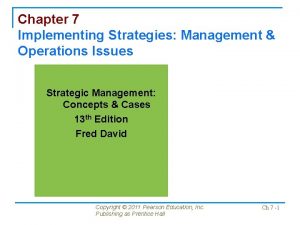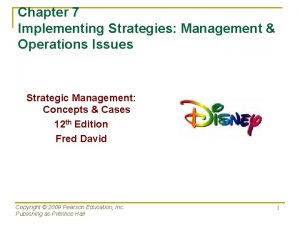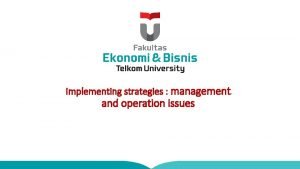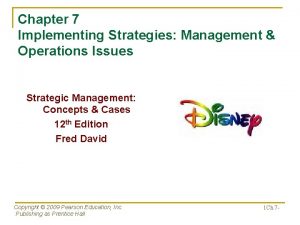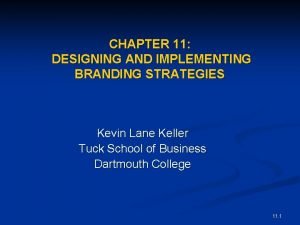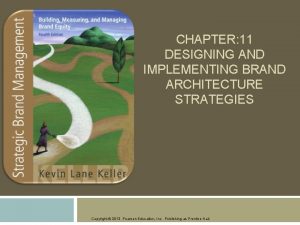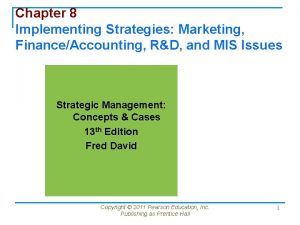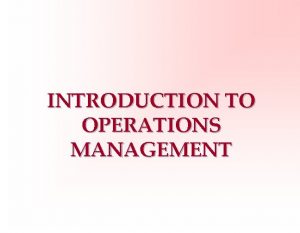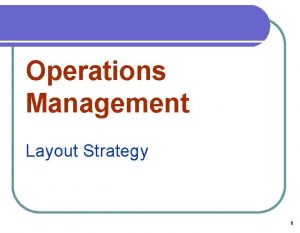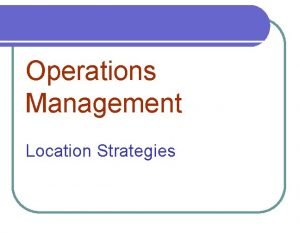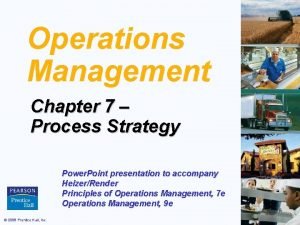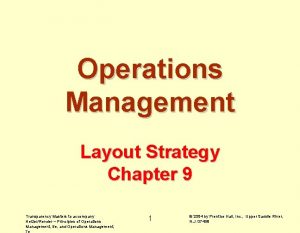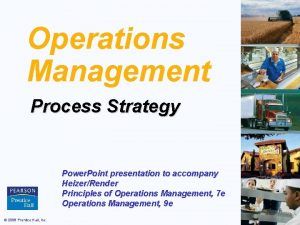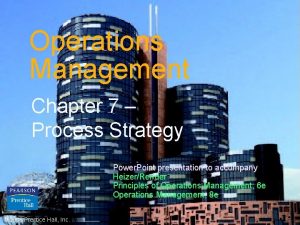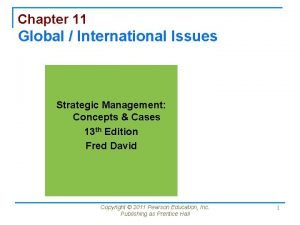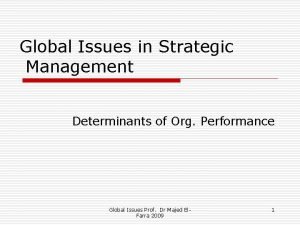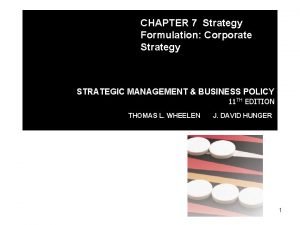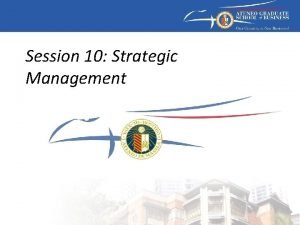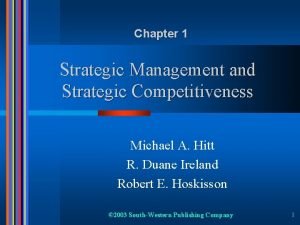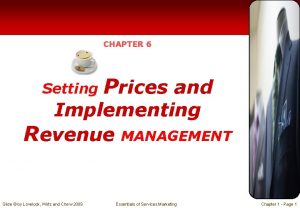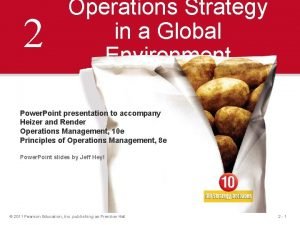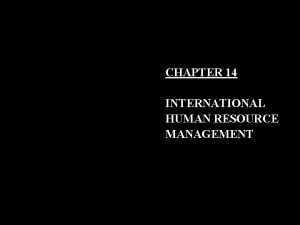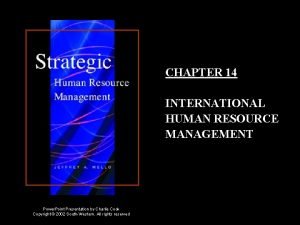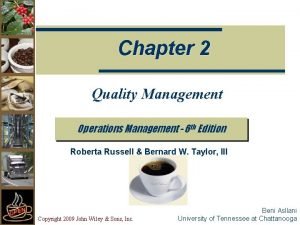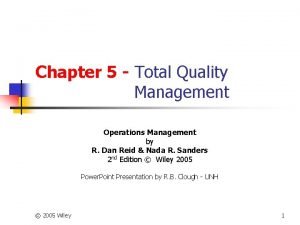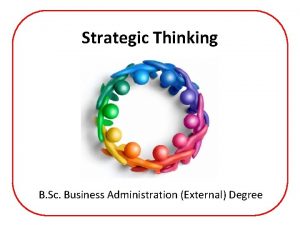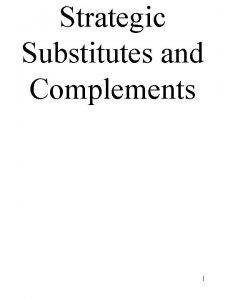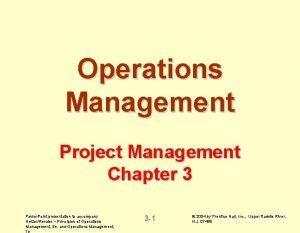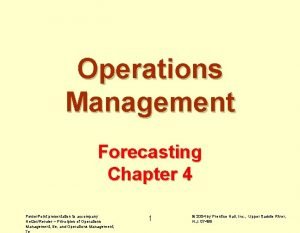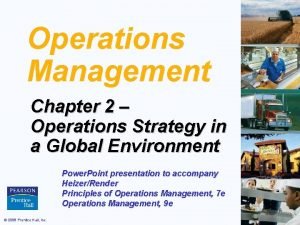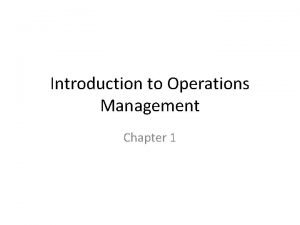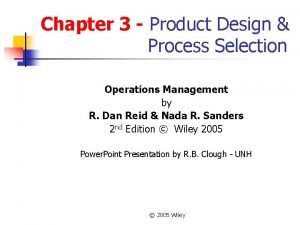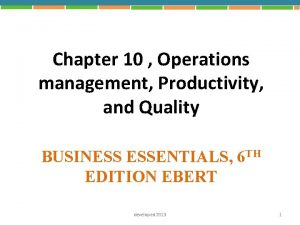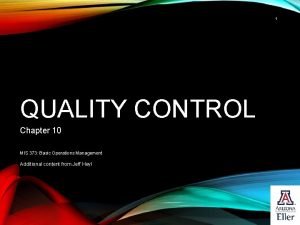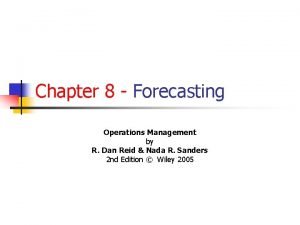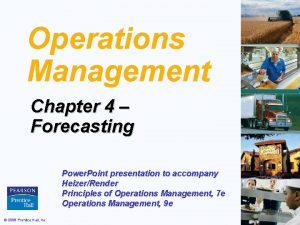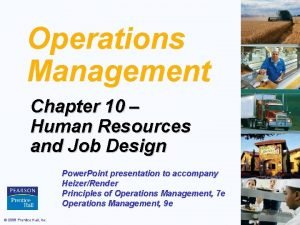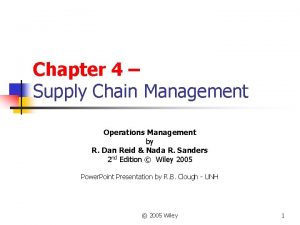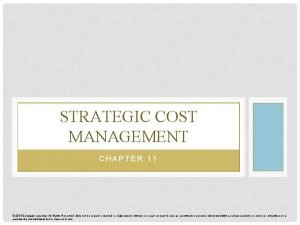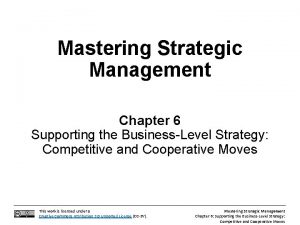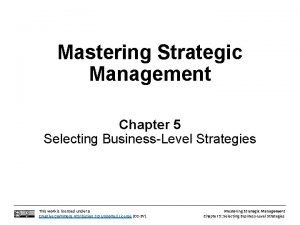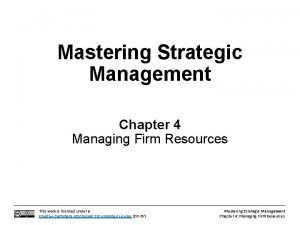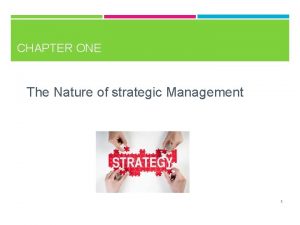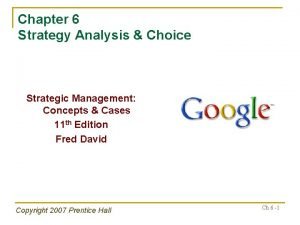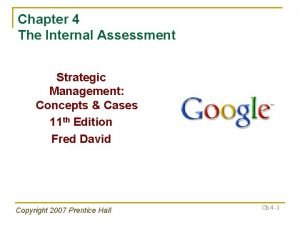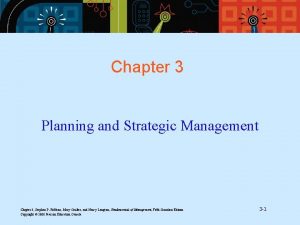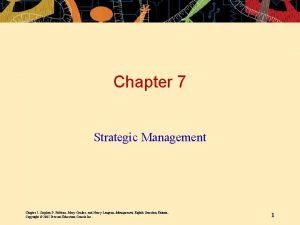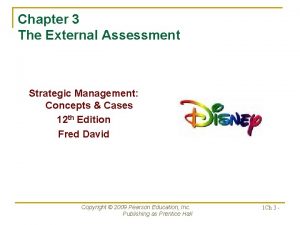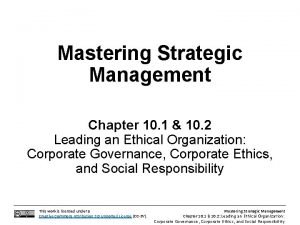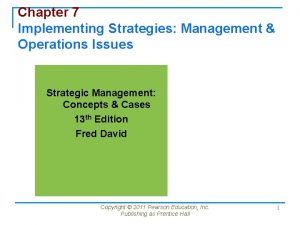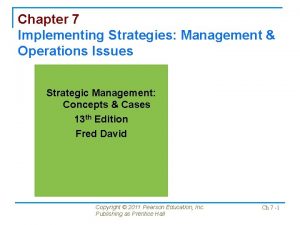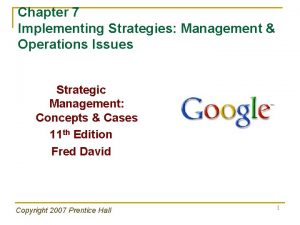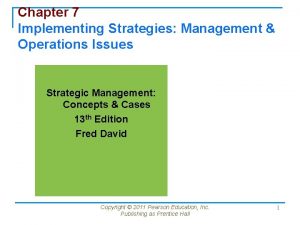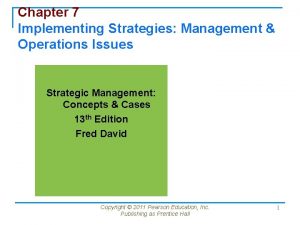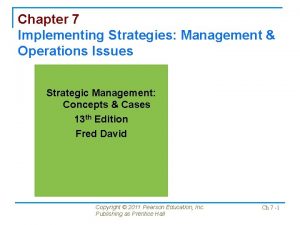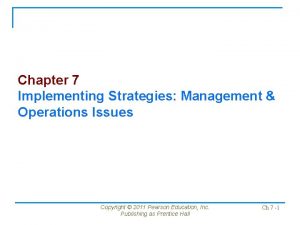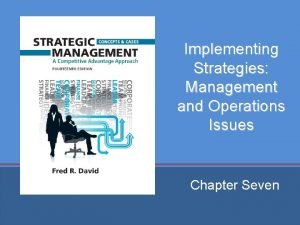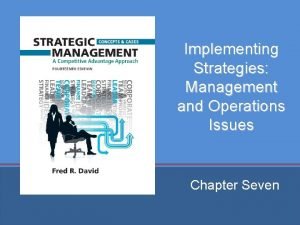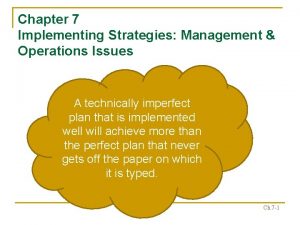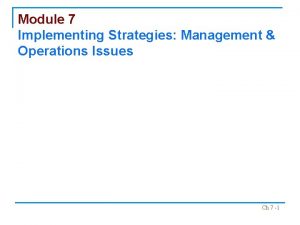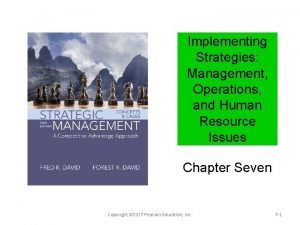Chapter 7 Implementing Strategies Management Operations Issues Strategic



















































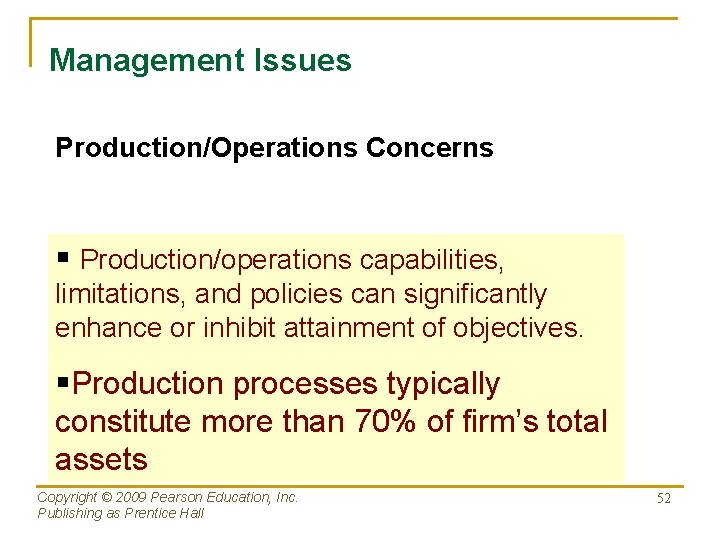

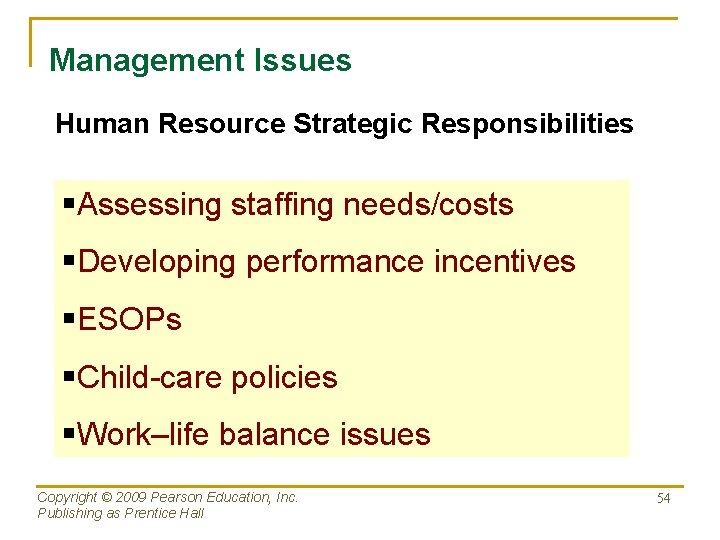
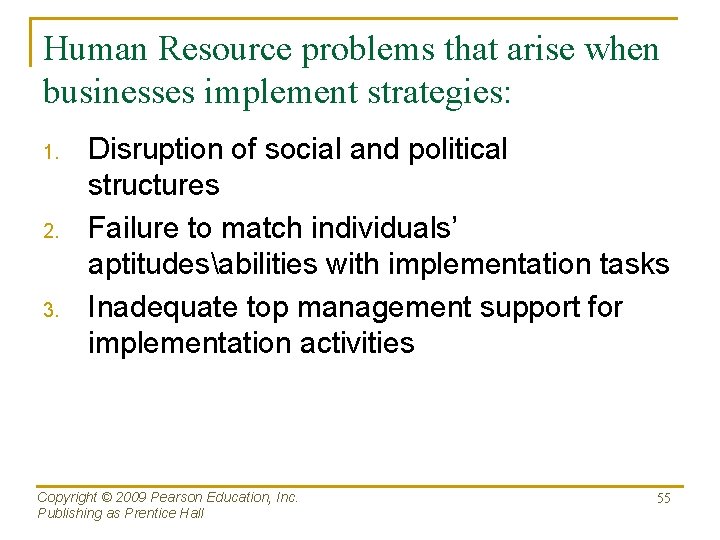
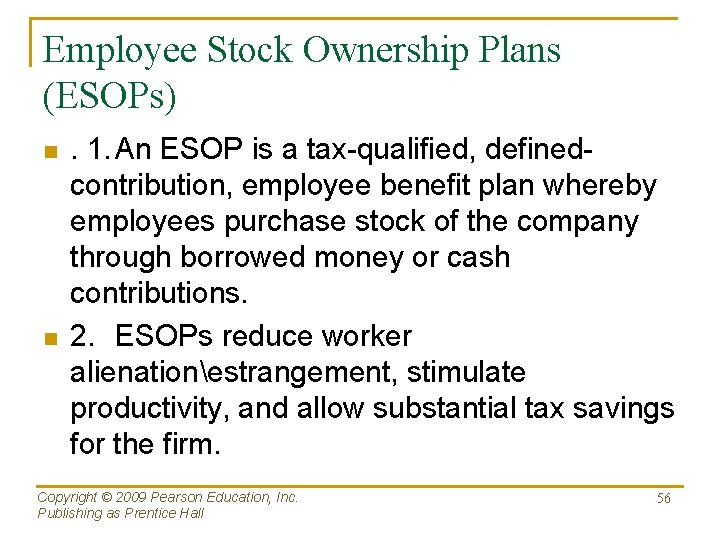
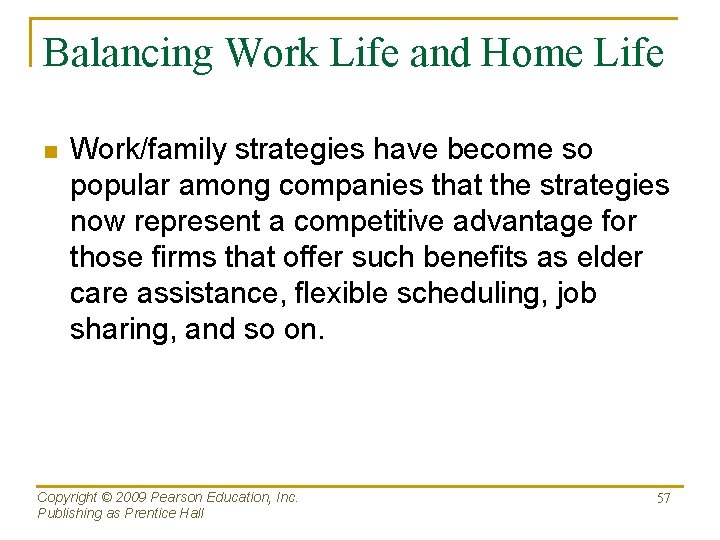
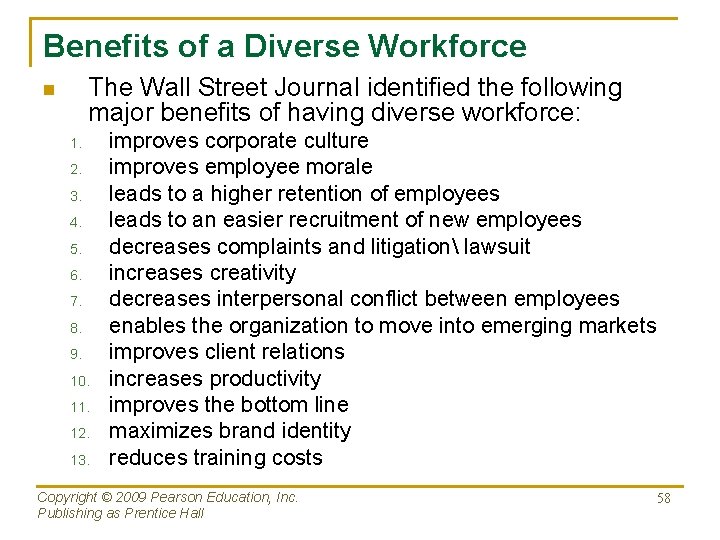
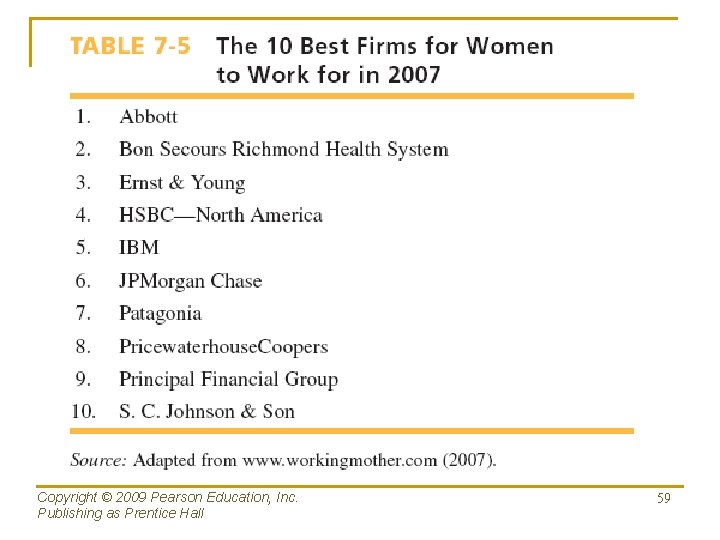
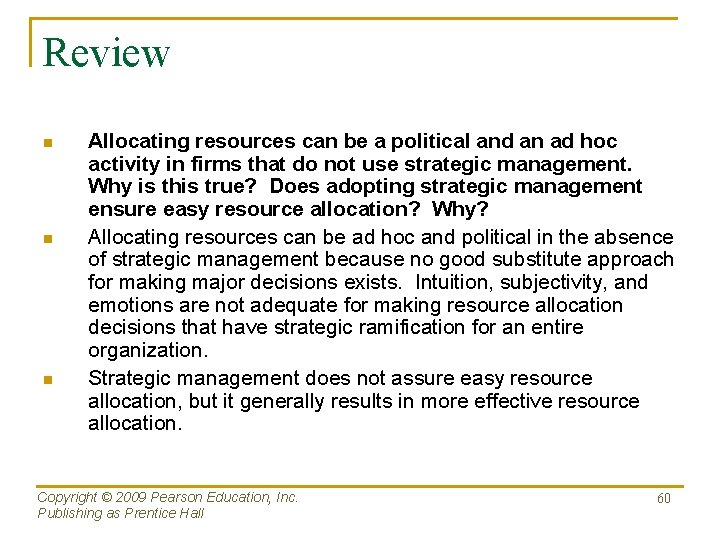

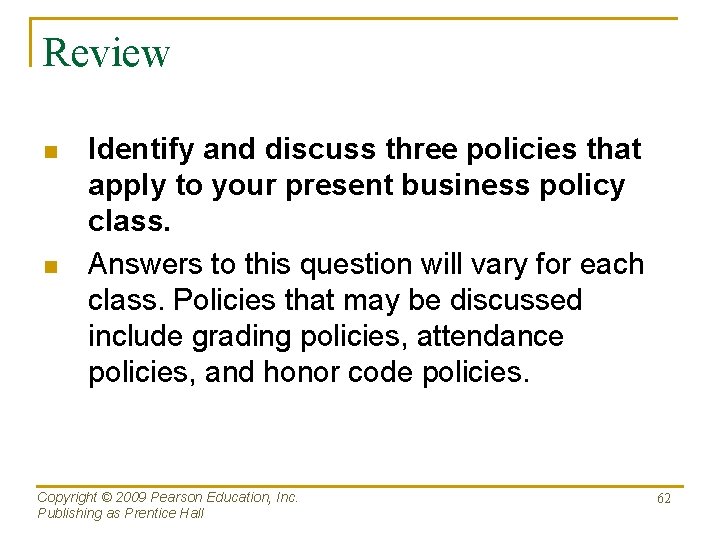
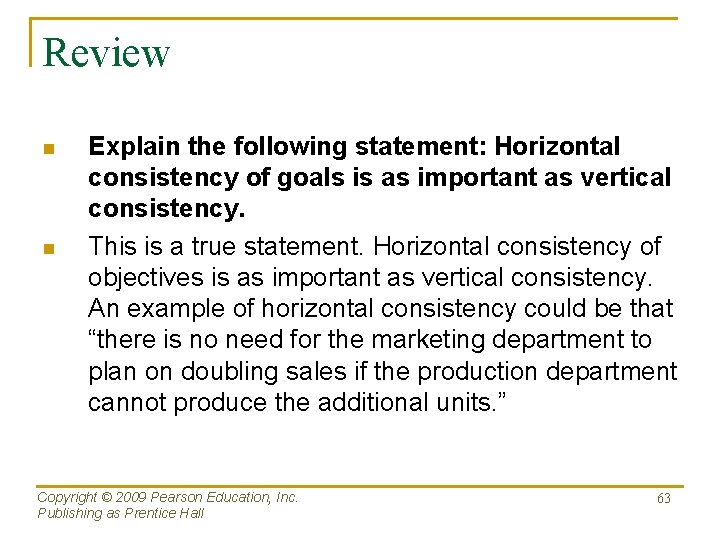

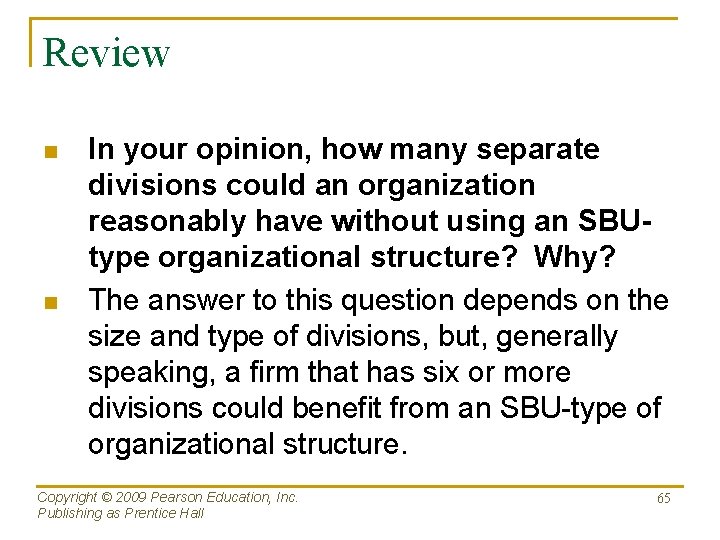
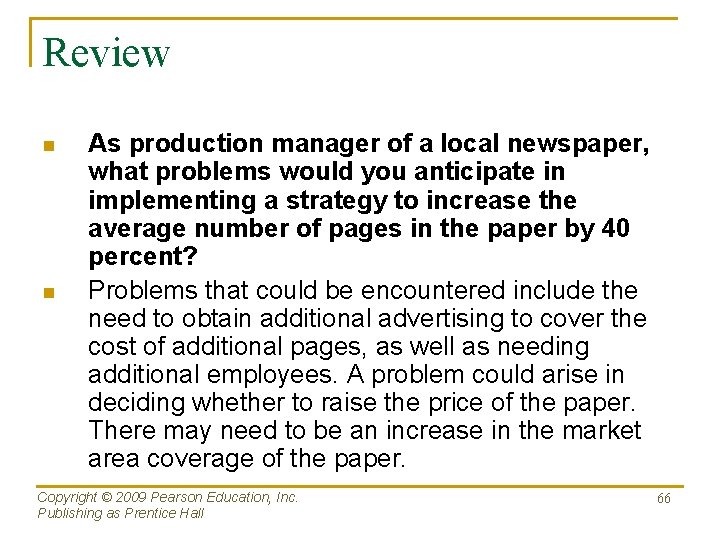
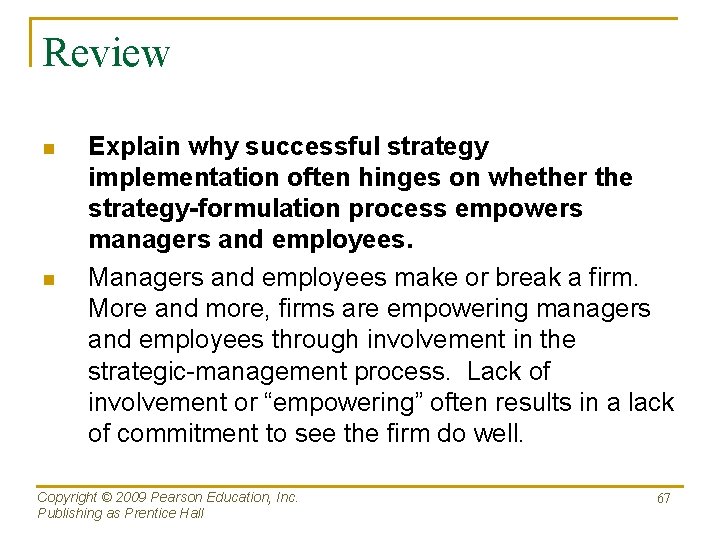

- Slides: 68

Chapter 7 Implementing Strategies: Management & Operations Issues Strategic Management: Concepts & Cases 12 th Edition Fred David Copyright © 2009 Pearson Education, Inc. Publishing as Prentice Hall 1

Copyright © 2009 Pearson Education, Inc. Publishing as Prentice Hall 2

Nature of Strategy Implementation Formulation vs. Implementation n Formulation focuses on effectiveness n Implementation focuses on efficiency Copyright © 2009 Pearson Education, Inc. Publishing as Prentice Hall 3

Strategy implementation n Successful strategy formulation does not guarantee successful strategy implementation. It is always more difficult to do something (strategy implementation) than to say you are going to do it (strategy formulation). Copyright © 2009 Pearson Education, Inc. Publishing as Prentice Hall 4

Management Perspectives n In all but the smallest organizations, the transition from strategy formulation to strategy implementation requires a shift in responsibility from strategists to divisional and functional managers. Copyright © 2009 Pearson Education, Inc. Publishing as Prentice Hall 5

Management Issues Annual Objectives Policies Management Issues Resources Organizational Structure Restructuring Rewards/Incentives Copyright © 2009 Pearson Education, Inc. Publishing as Prentice Hall 6

Management Issues (cont’d) Resistance to Change Natural Environment Management Issues Supportive Culture Production/Operations Human Resources Copyright © 2009 Pearson Education, Inc. Publishing as Prentice Hall 7

Management Perspectives n Management issues central to strategy implementation include establishing annual objectives, devising policies, allocating resources, altering an existing organizational structure, restructuring and reengineering, revising reward and incentive plans, minimizing resistance to change, matching managers with strategy, developing a strategy-supportive culture, adapting production/operations processes, developing an effective human resource function, and, if necessary, downsizing. Copyright © 2009 Pearson Education, Inc. Publishing as Prentice Hall 8

Management Perspectives n Managers and employees throughout an organization should participate early and directly in strategy-implementation decisions. Copyright © 2009 Pearson Education, Inc. Publishing as Prentice Hall 9

Nature of Strategy Implementation Management Perspectives n Shift in responsibility Strategists Copyright © 2009 Pearson Education, Inc. Publishing as Prentice Hall Divisional or Functional Managers 10

ANNUAL OBJECTIVES n n n 1. Establishing annual objectives is a decentralized activity that directly involves all managers in an organization. 2. Annual objectives are essential for strategy implementation because they: a. Represent the basis for allocating resources. b. Are a primary mechanism for evaluating managers. c. Are the major instrument for monitoring progress towards achieving long-term objectives. d. Establish organizational, divisional, and departmental priorities. Copyright © 2009 Pearson Education, Inc. Publishing as Prentice Hall 11

Management Issues Purpose of Annual Objectives – §Basis for resource allocation §Mechanism for management evaluation §Metric for gauging progress on long-term objectives §Establish priorities (organizational, divisional, and departmental) Copyright © 2009 Pearson Education, Inc. Publishing as Prentice Hall 12

Annual objectives n Annual objectives should be measurable, consistent, reasonable, challenging, clear, communicated throughout the organization, characterized by an appropriate time dimension, and accompanied by commensurate rewards and sanctions. Copyright © 2009 Pearson Education, Inc. Publishing as Prentice Hall 13

POLICIES n n n Changes in a firm’s strategic direction do not occur automatically. On a day-to-day basis, policies are needed to make a strategy work. Broadly defined, policy refers to specific guidelines, methods, procedures, rules, forms, and administrative practices established to support and encourage work toward stated goals. Policies let both employees and managers know what is expected of them, thereby increasing the likelihood that strategies will be implemented successfully. Copyright © 2009 Pearson Education, Inc. Publishing as Prentice Hall 14

Management Issues Four Types of Resources 1. Financial resources 2. Physical resources 3. Human resources 4. Technological resources Copyright © 2009 Pearson Education, Inc. Publishing as Prentice Hall 15

RESOURCE ALLOCATION n n n Resource allocation is a central management activity that allows for strategy execution. In organizations that do not use a strategicmanagement approach to decision making, resource allocation is often based on political or personal factors. Strategic management enables resources to be allocated according to priorities established by annual objectives. Copyright © 2009 Pearson Education, Inc. Publishing as Prentice Hall 16

MANAGING CONFLICT n n n A. Resource-Specific Conflict Interdependency of objectives and competition for limited resources often leads to conflict. Conflict can be defined as a disagreement between two or more parties on one or more issues. Copyright © 2009 Pearson Education, Inc. Publishing as Prentice Hall 17

Approaches for Managing and Resolving Conflict 1. Avoidance includes such actions as ignoring the problem in hopes that the conflict will resolve itself or physically separating the conflicting individuals (or groups). Copyright © 2009 Pearson Education, Inc. Publishing as Prentice Hall 18

Approaches for Managing and Resolving Conflict 1. Diffusion can include playing down differences between conflicting parties while emphasis similarities and common interests, compromising so that there is neither a clear winner nor loser, resorting to majority rule, appealing to a higher authority, or redesigning present positions. Copyright © 2009 Pearson Education, Inc. Publishing as Prentice Hall 19

Approaches for Managing and Resolving Conflict 1. Confrontation is exemplified by exchanging members of conflicting parties so that each can gain an appreciation of the other’s point of view, or holding a meeting at which conflicting parties present their views and work through their differences. Copyright © 2009 Pearson Education, Inc. Publishing as Prentice Hall 20

Management Issues Managing Conflict § Conflict not always “bad” § No conflict may signal apathy § Can energize opposing groups to action § May help managers identify problems Copyright © 2009 Pearson Education, Inc. Publishing as Prentice Hall 21

MATCHING STRATEGY WITH STRUCTURE n n A. Changes in Strategy Often Require Changes in Structure 1. Changes in strategy often require changes in the way an organization is structured for two major reasons. a. First, structure largely dictates how objectives and policies will be established. For example, objectives and policies established under a geographic organizational structure are couched in geographic terms. Objectives and policies are stated largely in terms of products in an organization whose structure is based on product groups. The structural formula for developing objectives and policies can significantly impact all other strategyimplementation issues. b. The second major reason why changes in strategy often require changes in structure is that structure dictates how resources will be allocated. Copyright © 2009 Pearson Education, Inc. Publishing as Prentice Hall 22

MATCHING STRATEGY WITH STRUCTURE n n Changes in strategy lead to changes in organizational structure. Structure should be designed to facilitate the strategic pursuit of a firm and, therefore, follow strategy. 3. There is not just one optimal organizational design or structure for a given strategy or type of organization. Copyright © 2009 Pearson Education, Inc. Publishing as Prentice Hall 23

Copyright © 2009 Pearson Education, Inc. Publishing as Prentice Hall 24

Management Issues Basic Forms of Structure § Functional Structure § Divisional Structure § Strategic Business Unit Structure (SBU) § Matrix Structure Copyright © 2009 Pearson Education, Inc. Publishing as Prentice Hall 25

The Functional Structure n n 1. The most widely used structure is the functional or centralized type because this structure is the simplest and least expensive of the seven alternatives. 2. A functional structure groups tasks and activities by business function such as product/operations, marketing, finance/accounting, R&D, and computer information systems. Copyright © 2009 Pearson Education, Inc. Publishing as Prentice Hall 26

The Functional Structure n Advantages: Besides being simple and inexpensive, a functional structure also promotes specialization of labor, encourages efficiency, minimizes the need for an elaborate control system, and allows rapid decision-making. Copyright © 2009 Pearson Education, Inc. Publishing as Prentice Hall 27

The Functional Structure n b. Disadvantages: Some disadvantages of a functional structure are that it forces accountability to the top, minimizes career development opportunities, and is sometimes characterized by low employee morale. Copyright © 2009 Pearson Education, Inc. Publishing as Prentice Hall 28

The Divisional Structure n n 1. The divisional or decentralized structure is the second most common type used by American businesses. The divisional structure can be organized in one of four ways: by geographic area, product or service, customer, or process. With a divisional structure, functional activities are performed both centrally and in each separate division. Copyright © 2009 Pearson Education, Inc. Publishing as Prentice Hall 29

The Divisional Structure n n Advantages: A divisional structure has some clear advantages. First, and perhaps foremost, is accountability. Other advantages of the divisional structure are that it creates career development opportunities for managers, allows local control of local situations, leads to a competitive climate within an organization, and allows new businesses and products to be added easily. b. Disadvantages: Perhaps the most important limitation is that a divisional structure is costly. Copyright © 2009 Pearson Education, Inc. Publishing as Prentice Hall 30

The Divisional Structure n n n 3. A divisional structure by geographic area is appropriate for organizations whose strategies need to be tailored to fit the particular needs and characteristics of customers in different geographic regions. 4. A division structure by product is most effective for implementing strategies when specific products or services need special emphasis. 5. A division structure by process is similar to a functional structure, because activities are organized according to the way work is actually performed. Copyright © 2009 Pearson Education, Inc. Publishing as Prentice Hall 31

The Strategic Business Unit (SBU) Structure n n The SBU structure groups similar divisions into strategic business units and delegates authority and responsibility for each unit to a senior executive who reports directly to the CEO. Advantages: This change in structure can facilitate strategy implementation by improving coordination between similar divisions and channeling accountability to distinct business units. It also makes the task of planning and control by the corporate office more manageable. Copyright © 2009 Pearson Education, Inc. Publishing as Prentice Hall 32

The Strategic Business Unit (SBU) Structure n Disadvantages: Two disadvantages of an SBU structure are that it requires an additional layer of management, which increases salary expenses, and the role of the group vice president is often ambiguous. Copyright © 2009 Pearson Education, Inc. Publishing as Prentice Hall 33

Copyright © 2009 Pearson Education, Inc. Publishing as Prentice Hall 34

The Matrix Structure n n It is the most complex of all designs because it depends upon both vertical and horizontal flows of authority and communication. It can result in higher overhead because it creates more managerial positions. It also creates dual lines of budget authority, dual sources of reward and punishment, shared authority, and dual reporting channels. Its advantages are that project objectives are clear, there are many channels of communication, workers can see visible results of work, and projects can be shut down easily. Copyright © 2009 Pearson Education, Inc. Publishing as Prentice Hall 35

Copyright © 2009 Pearson Education, Inc. Publishing as Prentice Hall 36

Copyright © 2009 Pearson Education, Inc. Publishing as Prentice Hall 37

Reshaping Corporate Landscape n n 1. Restructuring, also called downsizing, rightsizing, or delayering, involves reducing the size of the firm in terms of number of employees, divisions or units, and hierarchical levels in the firm’s organizational structure. 2. The Internet is ushering in a new wave of business transformations. Copyright © 2009 Pearson Education, Inc. Publishing as Prentice Hall 38

Reshaping Corporate Landscape n n Reengineering is concerned more with employee and customer well-being than with shareholder well-being. Reengineering, also called process management, process innovation, or process redesign, involves reconfiguring or redesigning work, jobs, and processes for the purpose of improving cost, quality, service, and speed. Copyright © 2009 Pearson Education, Inc. Publishing as Prentice Hall 39

Restructuring n n 1. Firms often employ restructuring when various ratios appear out of line with competitors, as determined through benchmarking exercises. 2. The primary benefit sought from restructuring is cost reduction. The downside of restructuring can be reduced employee commitment, creativity, and innovation that accompanies the uncertainty and trauma associated with pending and actual employee layoffs. Copyright © 2009 Pearson Education, Inc. Publishing as Prentice Hall 40

Management Issues Restructuring §Downsizing §Rightsizing §Delayering Copyright © 2009 Pearson Education, Inc. Publishing as Prentice Hall 41

LINKING PERFORMANCE AND PAY TO STRATEGIES n n n Profit sharing is a widely used form of incentive compensation. Gain sharing requires employees or departments to establish performance targets; if actual results exceed objectives, all members get bonuses. Criteria such as sales, profit, production efficiency, quality, and safety could also serve as bases for an effective bonus system. Copyright © 2009 Pearson Education, Inc. Publishing as Prentice Hall 42

Tests for Performance-Pay Plans Does the plan capture attention? Do employees understand the plan? Is the plan improving communication? Does the plan pay out when it should? Is the company or unit performing better? 43

Natural Environment Perspective In Hiring, Do Companies Consider Environmental Training? n n n 77% of corporate recruiters believe it’s important to hire students with an awareness of social and environmental responsibility Most schools do not incorporate environmental training in core curriculum Research suggest that business schools need to do more to prepare students Copyright © 2009 Pearson Education, Inc. Publishing as Prentice Hall 44

MANAGING RESISTANCE TO CHANGE n n n n A. Resistance to Change It may take on such forms as sabotaging production machines, absenteeism, filing unfounded grievances, and an unwillingness to cooperate. Resistance to change can emerge at any stage or level of the strategy-implementation process. There are three commonly used strategies for implementing change: a. Force change strategy Educative change strategy Self-interest change strategy Copyright © 2009 Pearson Education, Inc. Publishing as Prentice Hall 45

Creating a Strategy-Supportive Culture n n Strategists should strive to preserve, emphasize, and build on aspects of an existing culture that support proposed new strategies. Jack Duncan described triangulation as an effective, multimethod technique for studying and altering a firm’s culture. Copyright © 2009 Pearson Education, Inc. Publishing as Prentice Hall 46

Creating a Strategy-Supportive Culture Triangulation includes the combined use of prominent observation, selfadministered questionnaires, and personal interviews to determine the nature of a firm’s culture. q The process of triangulation reveals needed changes in a firm’s culture that could benefit strategy. q Copyright © 2009 Pearson Education, Inc. Publishing as Prentice Hall 47

The Mexican Culture n n 1. Mexico always has been and still is an authoritarian society in terms of schools, churches, businesses, and families. Employers seek workers who are agreeable, respectful, and obedient, rather than innovative, creative, and independent. Mexican workers tend to be activity oriented rather than problem solvers. 2. Mexican employers are paternalistic, providing workers with more than a paycheck, but in return, they expect allegianceloyality. Copyright © 2009 Pearson Education, Inc. Publishing as Prentice Hall 48

The Japanese Culture n n 1. The Japanese place great importance on group loyalty and consensus, a concept called wa. Nearly all corporate activities in Japan encourage wa among managers and employees. Wa requires that all members of a group agree and cooperate; this results in constant discussion and compromise. 2. Most Japanese managers are reserved, quiet, distant, introspectivethoughtful, and other oriented, whereas most U. S. managers are talkative, insensitive, impulsiverash, direct, and individual oriented. Copyright © 2009 Pearson Education, Inc. Publishing as Prentice Hall 49

Creating a Strategy-Supportive Culture Copyright © 2009 Pearson Education, Inc. Publishing as Prentice Hall 50

Copyright © 2009 Pearson Education, Inc. Publishing as Prentice Hall 51

Management Issues Production/Operations Concerns § Production/operations capabilities, limitations, and policies can significantly enhance or inhibit attainment of objectives. §Production processes typically constitute more than 70% of firm’s total assets Copyright © 2009 Pearson Education, Inc. Publishing as Prentice Hall 52

Management Issues Examples on adjustment of Production/Operations Decisions §Plant size §Inventory/Inventory control §Quality control §Cost control §Technological innovation Copyright © 2009 Pearson Education, Inc. Publishing as Prentice Hall 53

Management Issues Human Resource Strategic Responsibilities §Assessing staffing needs/costs §Developing performance incentives §ESOPs §Child-care policies §Work–life balance issues Copyright © 2009 Pearson Education, Inc. Publishing as Prentice Hall 54

Human Resource problems that arise when businesses implement strategies: 1. 2. 3. Disruption of social and political structures Failure to match individuals’ aptitudesabilities with implementation tasks Inadequate top management support for implementation activities Copyright © 2009 Pearson Education, Inc. Publishing as Prentice Hall 55

Employee Stock Ownership Plans (ESOPs) n n . 1. An ESOP is a tax-qualified, definedcontribution, employee benefit plan whereby employees purchase stock of the company through borrowed money or cash contributions. 2. ESOPs reduce worker alienationestrangement, stimulate productivity, and allow substantial tax savings for the firm. Copyright © 2009 Pearson Education, Inc. Publishing as Prentice Hall 56

Balancing Work Life and Home Life n Work/family strategies have become so popular among companies that the strategies now represent a competitive advantage for those firms that offer such benefits as elder care assistance, flexible scheduling, job sharing, and so on. Copyright © 2009 Pearson Education, Inc. Publishing as Prentice Hall 57

Benefits of a Diverse Workforce The Wall Street Journal identified the following major benefits of having diverse workforce: n 1. 2. 3. 4. 5. 6. 7. 8. 9. 10. 11. 12. 13. improves corporate culture improves employee morale leads to a higher retention of employees leads to an easier recruitment of new employees decreases complaints and litigation lawsuit increases creativity decreases interpersonal conflict between employees enables the organization to move into emerging markets improves client relations increases productivity improves the bottom line maximizes brand identity reduces training costs Copyright © 2009 Pearson Education, Inc. Publishing as Prentice Hall 58

Copyright © 2009 Pearson Education, Inc. Publishing as Prentice Hall 59

Review n n n Allocating resources can be a political and an ad hoc activity in firms that do not use strategic management. Why is this true? Does adopting strategic management ensure easy resource allocation? Why? Allocating resources can be ad hoc and political in the absence of strategic management because no good substitute approach for making major decisions exists. Intuition, subjectivity, and emotions are not adequate for making resource allocation decisions that have strategic ramification for an entire organization. Strategic management does not assure easy resource allocation, but it generally results in more effective resource allocation. Copyright © 2009 Pearson Education, Inc. Publishing as Prentice Hall 60

Review n n Compare strategy formulation with strategy implementation in terms of each being an art or a science. The strategy-formulation process is more of a science, whereas strategy implementation is more of an art. Strategy implementation involves motivating employees. However, neither strategy formulation nor strategy implementation is a pure science or art because, for example, intuition and good subjective judgment are always essential in strategy formulation. Copyright © 2009 Pearson Education, Inc. Publishing as Prentice Hall 61

Review n n Identify and discuss three policies that apply to your present business policy class. Answers to this question will vary for each class. Policies that may be discussed include grading policies, attendance policies, and honor code policies. Copyright © 2009 Pearson Education, Inc. Publishing as Prentice Hall 62

Review n n Explain the following statement: Horizontal consistency of goals is as important as vertical consistency. This is a true statement. Horizontal consistency of objectives is as important as vertical consistency. An example of horizontal consistency could be that “there is no need for the marketing department to plan on doubling sales if the production department cannot produce the additional units. ” Copyright © 2009 Pearson Education, Inc. Publishing as Prentice Hall 63

Review n n In your opinion, what approaches to conflict resolution would be best for resolving a disagreement between a personnel manager and a sales manager over the firing of a particular salesperson? Why? Various approaches for minimizing and resolving conflict can be classified in three ways: avoidance, defusion, and confrontation. Depending on the situation, any of these three alternative approaches could justifiably be most effective in solving a dispute between a personnel manager and sales manager. Copyright © 2009 Pearson Education, Inc. Publishing as Prentice Hall 64

Review n n In your opinion, how many separate divisions could an organization reasonably have without using an SBUtype organizational structure? Why? The answer to this question depends on the size and type of divisions, but, generally speaking, a firm that has six or more divisions could benefit from an SBU-type of organizational structure. Copyright © 2009 Pearson Education, Inc. Publishing as Prentice Hall 65

Review n n As production manager of a local newspaper, what problems would you anticipate in implementing a strategy to increase the average number of pages in the paper by 40 percent? Problems that could be encountered include the need to obtain additional advertising to cover the cost of additional pages, as well as needing additional employees. A problem could arise in deciding whether to raise the price of the paper. There may need to be an increase in the market area coverage of the paper. Copyright © 2009 Pearson Education, Inc. Publishing as Prentice Hall 66

Review n n Explain why successful strategy implementation often hinges on whether the strategy-formulation process empowers managers and employees. Managers and employees make or break a firm. More and more, firms are empowering managers and employees through involvement in the strategic-management process. Lack of involvement or “empowering” often results in a lack of commitment to see the firm do well. Copyright © 2009 Pearson Education, Inc. Publishing as Prentice Hall 67

Review n n Discuss three ways the book discusses linking performance and pay to strategies. Some methods of linking performance to pay include profit sharing, gain sharing, and bonus systems. Profit sharing is widely used but can be a less than desirable criterion since individuals may not be clearly able to affect profits. Gain sharing requires employees or departments to establish performance targets. If actual results exceed objectives, all members get bonuses. In a bonus system, if an organization meets certain agreedupon objectives, every member of the enterprise shares in the benefits. Criteria for bonus systems include sales, profit, production efficiency, quality and safety. Copyright © 2009 Pearson Education, Inc. Publishing as Prentice Hall 68
 Implementing strategies management and operations issues
Implementing strategies management and operations issues Mis issues in strategy implementation
Mis issues in strategy implementation Implementing strategies: management and operations issues
Implementing strategies: management and operations issues Strategic business unit structure
Strategic business unit structure Implementing strategies management and operations issues
Implementing strategies management and operations issues Designing and implementing branding strategies
Designing and implementing branding strategies Designing and implementing branding strategies
Designing and implementing branding strategies Finance and accounting issues in strategy implementation
Finance and accounting issues in strategy implementation Low end entry level brand
Low end entry level brand Contemporary management practice
Contemporary management practice Issues in operations management
Issues in operations management Role of operations manager
Role of operations manager What are the seven layout strategies?
What are the seven layout strategies? Location strategy analysis
Location strategy analysis Process strategy in operations management
Process strategy in operations management Layout strategy in operations management
Layout strategy in operations management Operations management process strategy
Operations management process strategy Process strategy in operations management
Process strategy in operations management Global international issues in strategic management
Global international issues in strategic management Global international issues in strategic management
Global international issues in strategic management Global issues in strategic management
Global issues in strategic management Captive company strategy
Captive company strategy Strategies in action
Strategies in action Intensive strategies in strategic management
Intensive strategies in strategic management Functional strategies in strategic management
Functional strategies in strategic management Retail strategy
Retail strategy Resource based model
Resource based model Cultural aspects of strategy choice
Cultural aspects of strategy choice Chapter 12 inventory management
Chapter 12 inventory management The pricing tripod
The pricing tripod Simplified scoring model in project management
Simplified scoring model in project management Four international operations strategies
Four international operations strategies Identifying strategic issues facing the organization
Identifying strategic issues facing the organization Strategic issues in entrepreneurial ventures
Strategic issues in entrepreneurial ventures Strategic hr issues in global assignments
Strategic hr issues in global assignments Strategic issues in managing technology and innovation
Strategic issues in managing technology and innovation Ihrm ppt
Ihrm ppt Quality management in operations management
Quality management in operations management What is tqm
What is tqm Strategic fit vs strategic intent
Strategic fit vs strategic intent Tirole
Tirole Operations management chapter 3 solutions
Operations management chapter 3 solutions Operations management chapter 4 forecasting solutions
Operations management chapter 4 forecasting solutions Operation strategy example
Operation strategy example Chapter 1 introduction to operations management
Chapter 1 introduction to operations management Process selection operations management
Process selection operations management Operations management chapter 10
Operations management chapter 10 Asq control chart
Asq control chart Chapter 8 operations management
Chapter 8 operations management Forecasting in operations management
Forecasting in operations management Forecasting in operations management ppt
Forecasting in operations management ppt Chapter 11 operations management
Chapter 11 operations management Job design continuum
Job design continuum Chapter 4 operations management
Chapter 4 operations management Chapter 2 operations strategy and competitiveness
Chapter 2 operations strategy and competitiveness Chapter 11 strategic cost management
Chapter 11 strategic cost management Mastering strategic management
Mastering strategic management Strategic management chapter 5
Strategic management chapter 5 Strategic management chapter 4
Strategic management chapter 4 Strategic management chapter 1
Strategic management chapter 1 Strategic management chapter 9
Strategic management chapter 9 Chapter 7 strategic management
Chapter 7 strategic management Strategic management chapter 6
Strategic management chapter 6 Integrating strategy and culture in internal assessment
Integrating strategy and culture in internal assessment Chapter 3 strategic management
Chapter 3 strategic management Strategic management chapter 7
Strategic management chapter 7 What is external audit in strategic management
What is external audit in strategic management Strategic management chapter 10
Strategic management chapter 10 Strategic cost management chapter 1
Strategic cost management chapter 1
